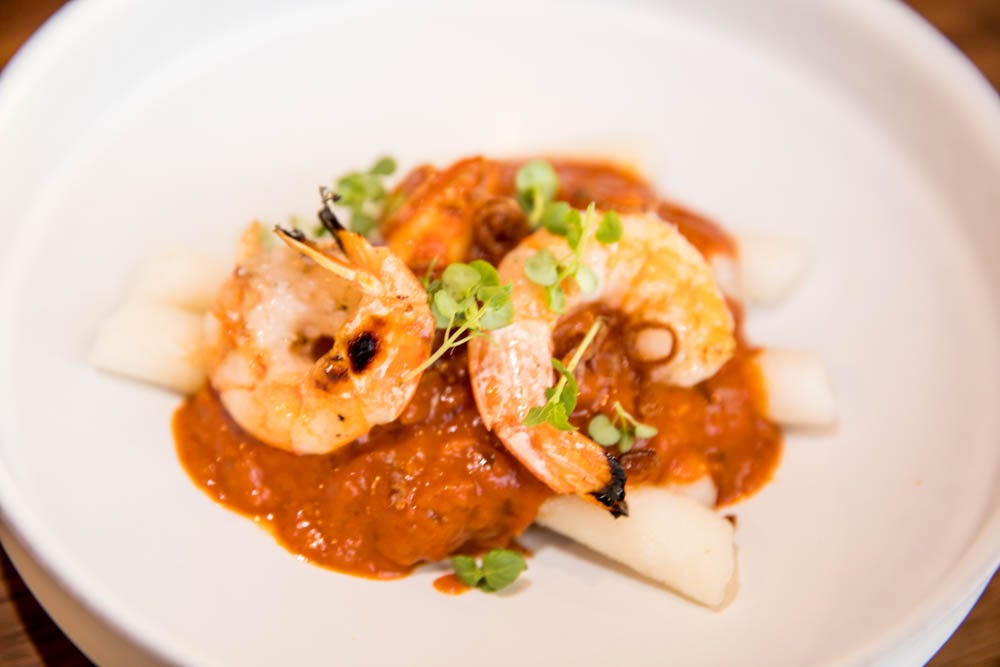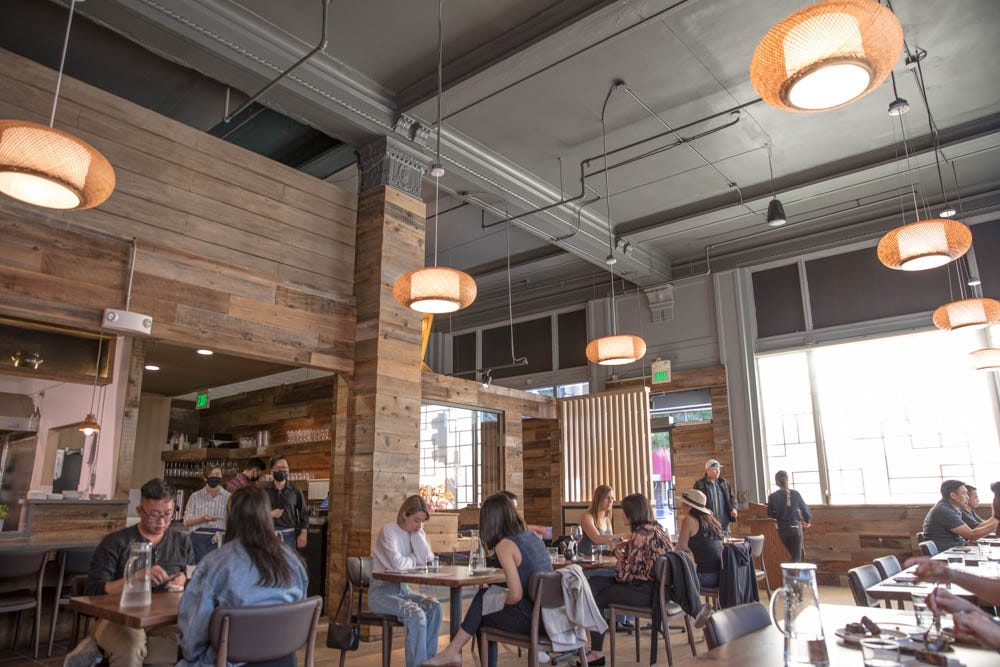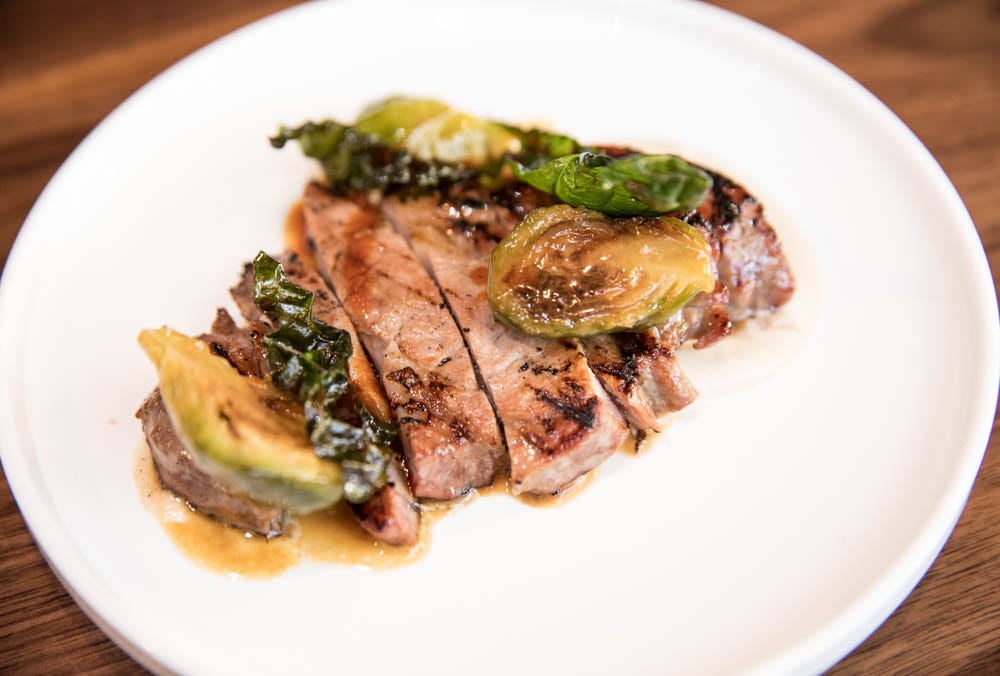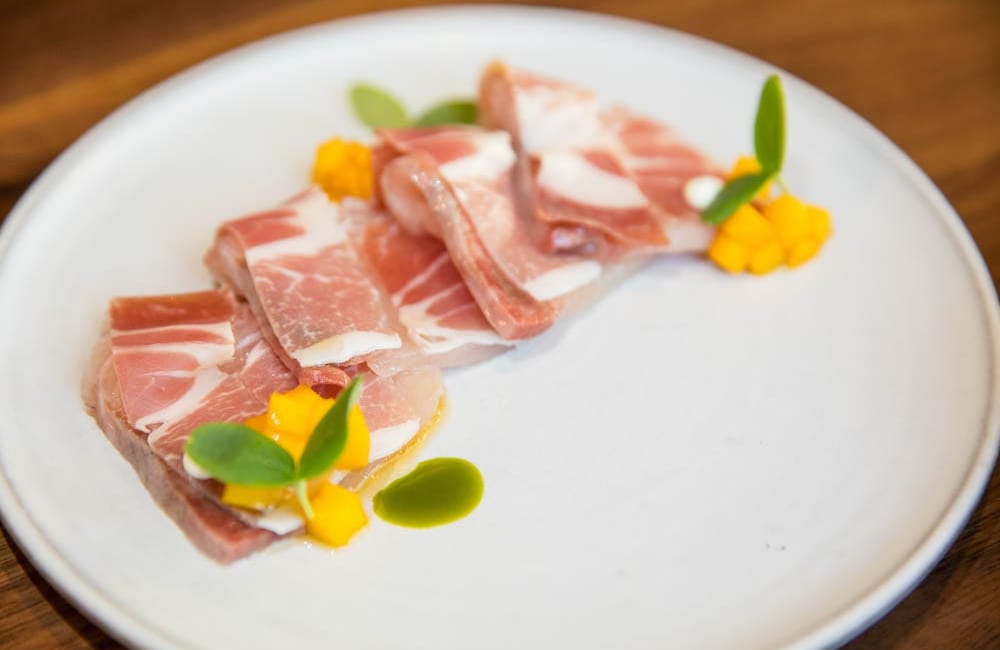Opening a more upscale, untried concept on a block that already holds three Michelin-starred restaurants — State Bird Provisions, The Progress and Avery — is ambitious, to say the least. When it is one that needs tightening up, as brand new Bansang does, it’s even riskier. But in its initial soft opening month of May (opening the tail end of April 2022), Bansang’s promise is all on the plate.
True: we started our first couple courses with plates so tiny that when our yuzu pear salad arrived, dotted with mint, feta cheese, pickled onions and candied walnuts — even one piece of butter lettuce wouldn’t fit on the plate, making it impossible to cut the large leaves. I asked for larger (read: normal-sized) plates and voilà! They had them. So why weren’t these offered initially?
Service was earnest and sweet from the moment I walked in with husband (Dan, the Renaissance Man, as many of our friends call him) and lifelong best friend visiting from Manhattan. But it was a series of little but obvious missteps that had me worried for Bansang when so many have already thought through those elements pre-opening. Seeing other tables with metal chopsticks, we also had to ask for those to start with our banchan. Hmmm…

The bad funk-meets-80s lounge music when we arrived was another bummer, raising the energy of the open dining room, but not in a good way. As it mellowed to smooth jazz mode into dinner, this still wasn’t appealing but at least it was less frenetic.
Kudos to the staff for trying to figure out sake options, but essentially we couldn’t find a server who could advise on the flavor profiles of the sake by carafe or glass, so thankfully I know my sake and soju and could navigate — even better, three different beers by the can from SF Korean brewer Dokkaebier beers are on offer, one of the savvier options.
From wine to soju, the short drink list was solid but not a draw, especially as a tighter drink list (which I appreciate) should have uber-savvy choices to suit a range of palates. Asking for a more umami, savory sake led us to a dry, understated, basic one. The norm in San Francisco is to ask such a question and get a range of spot-on options, certainly from sommeliers, but even from most servers. The sake I ended up with was far from what I sought out.
It’s hard enough to survive as a restaurant. Period. Much less in a city with tight, world-class competition in every neighborhood, and in this case, literally from next door neighbors. The category of upscale Korean has less (but growing) competition, so that helps, but honing the drink list and staff training on it should be high on their priority list when literally hundreds of restaurants of their level and price point excel on drink pairings.

But when it comes to the food, both in terms of execution and taste, this is where Bansang shows deep promise. It will need to be “whole package” and tighten up, if not shine at elements like drink, proper plateware and music, to be competitive in a city like ours. But for modern Korean, the food exhibits balance, vision and sheer deliciousness.
Korean restaurant group and Japantown neighbor Daeho (which continuously draws long lines) is behind Bansang, which opened in the former Izakaya Kou, a previously more closed-in, narrow space. It’s now light-filled and lofty. Bansang’s chef duo actually met in culinary school in Korea: Ethan Min cooked at the likes of Atelier Crenn, Saison and now-closed Kinjo sushi, while Jin Lim came from Michael Mina, Kinjo and Kabuto. Although Korean flavors dominate, French and Japanese technique and ingredients flow throughout, from uni (sea urchin) to a play on French beef tartare. But even a couple of Italian touches — prosciutto or their killer gojuchang tomato sauce — confirm this is globally-influenced Korean.
Banchan (Korean small side dishes) on my visit was a tangy cucumber salad, crispy tomato kimchi and nurturing mussel seaweed soup. These bites are simple and bright, as are the likes of kimchi oysters in white kimchi salsa and seaweed oil, inflected with sea bean.
As one starts delving into the shareable small-to-medium-sized plates, this is where Min and Lim’s skills overwhelm little missteps in ambience, pairing and plating. Silky yellowtail wrapped in prosciutto was a unique and dreamy crudo-meets-Italian prosciutto and melon sort of feel. Accented with wasabi cream, dill oil, mango salsa and melon greens, it was a play in contrasts and a fresh take on ubiquitous crudo dishes on menus these days.

Another tired offering can be steak tartare. I’ve long been crazy about traditional Korean tartare where bigger chunks of raw beef mingle with Asian pear. Here, chefs Lim and Min employ French technique with smaller cuts of beef sirloin tartare scooped up with baguette toasts, but go Korean in vibrant, red, appropriately (but not overwhelmingly) spicy gochujang sauce. Chive crème fraîche and roasted jalapeno provide contrast, the French classic making an easy transition to Korean flavors.
The chefs seem to particularly nail it when it comes to meats. A squeeze of lime perks up lime soy fried chicken so that it supercedes many a great KFC (Korean fried chicken) around. Being delicately battered, it’s lighter than many a KFC, yet invigorated with lime, cilantro, blistered shishito peppers and a vinegary-good palate cleanser of omija radish pickles on the side. It’s the obvious hit and should please anyone with a culinary pulse — even your basic comfort food types.
Dark miso marinated pork collar is so tender, it’s one of the better pork dishes I’ve had in awhile. Accompanying brussels sprouts, savoy cabbage puree, sauteed kale and leeks vinaigrette hit the right vegetal notes. It tastes like the best Korean pork dishes I’ve had historically, from Asia to growing up in suburbs of New York and LA. It’s an easy highlight.
Starchy, dense tteokbokki, or simmered rice cake (some menus dub it “Korean pasta”), is often chewy filler. But here, with a little pan-sear, they retain a mochi-like spirit with a welcome crispiness. Three grilled shrimp, perilla leaves and fried shallots sing in the lively gochujang tomato sauce. It tastes like the ultimate Korean pasta, true to its tteok-bokki roots, but with a tomato-forward sauce that could delight picky Italians (like me).

Radish kimchi fried rice is yet another “ultimate comfort food” kind of dish, savory with soy-braised pork and Parmesan cheese, a delicate poached egg oozing over the rice when poked, adding fluffy, silken texture.
While it may seem unfair to call out missteps a couple weeks in at a new restaurant — especially these days — I have dined at over 12,000 restaurants globally and just about everywhere locally. And in a few thousand cases, I’ve dined within the first week to 6 weeks of opening. This is my standard initial look at most new openings in town and I’m sorry to say Bansang had more little missteps than many do locally at merely a couple weeks in. But I say something because I want to see them tighten up, hone and sharpen. Why? If it wasn’t already obvious, it’s because what Lim and Min are cooking here deserves to be experienced, paired with on the next level drink-wise — and the sweetheart staff should be in on the story.
I want them to succeed and evolve to full potential, even on a block lined with globally-competitive excellence. One bite of that lime soy fried chicken or miso pork collar and you’ll want them to stick around, too.







